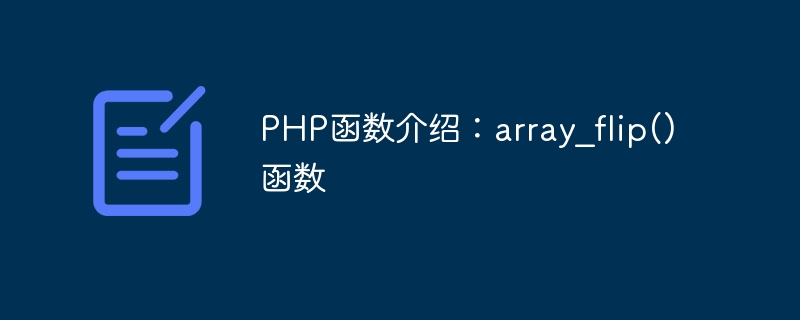

PHP function introduction: array_flip() function
In PHP programming, array is a very commonly used data structure, and the array_flip() function is provided by PHP One of the very practical functions. This article will introduce readers to the usage of array_flip() function in detail and provide specific code examples.
The array_flip() function is to exchange the keys and values in the array, that is, the keys of the array are used as values and the values are used as keys. It accepts an array as a parameter and returns a new array in which the keys of the original array become the values of the new array and the values of the original array become the keys of the new array.
The following is the syntax of the array_flip() function:
array array_flip ( array $array )
Parameter description:
Return value:
Below we demonstrate the usage of the array_flip() function through some specific code examples.
$array = array("a" => 1, "b" => 2, "c" => 3);
$flippedArray = array_flip($array);
print_r($flippedArray);Output result:
Array
(
[1] => a
[2] => b
[3] => c
)In the above example, we define an associative array $array, and then use the array_flip() function to key the array Value exchange. As can be seen from the final output of $flippedArray, the key "a" of the original array becomes the value 1 of the new array, and the value 1 of the original array becomes the key "a" of the new array. The same operation is applied to other keys and value.
$array = array("apple" => "red", "banana" => "yellow", "orange" => "orange", "grape" => "purple");
$flippedArray = array_flip($array);
print_r($flippedArray);Output result:
Array
(
[red] => apple
[yellow] => banana
[orange] => orange
[purple] => grape
)In the above example, we defined an associative array $array, the key of the array represents the name of the fruit, and the value represents Fruit color. After using the array_flip() function to perform key-value exchange on the array, the value in the result represents the color of the fruit, and the key represents the corresponding fruit name.
$array = array(1 => "a", 2 => "b", 3 => "c", 4 => "a"); $flippedArray = array_flip($array); print_r($flippedArray);
Output result:
Array
(
[a] => 4
[b] => 2
[c] => 3
)In this example, we define an array $array with a numerical index, and use the array_flip() function to Perform key-value exchange. The value in the result represents the value in the original array, and the key represents the last index value of the same value in the original array.
Use the array_flip() function to easily exchange the keys and values of the array and get a new array. However, it should be noted that the keys and values of the original array must be string or integer types to be used normally. An error will be reported when the value of the original array is not of string or integer type.
Summary:
The array_flip() function is a very practical PHP function through which you can easily exchange the keys and values of the array. In actual programming, the array_flip() function is often used for key-value exchange in associative arrays. Through the introduction of this article, we believe that readers have mastered the basic usage of the array_flip() function and can flexibly apply it in actual PHP programming.
The above is the detailed content of PHP function introduction: array_flip() function. For more information, please follow other related articles on the PHP Chinese website!
 How to clean up the computer's C drive when it is full
How to clean up the computer's C drive when it is full
 fil currency price real-time price
fil currency price real-time price
 How to defend cloud servers against DDoS attacks
How to defend cloud servers against DDoS attacks
 How to download Binance
How to download Binance
 How to buy and sell Bitcoin on Huobi.com
How to buy and sell Bitcoin on Huobi.com
 How to open iso file
How to open iso file
 What are the functions of computer networks
What are the functions of computer networks
 how to hide ip address
how to hide ip address
 How to solve problems when parsing packages
How to solve problems when parsing packages